Mark Sisson's Blog, page 290
August 15, 2014
Taking Primal to the Next Level
It’s Friday, everyone! And that means another Primal Blueprint Real Life Story from a Mark’s Daily Apple reader. If you have your own success story and would like to share it with me and the Mark’s Daily Apple community please contact me here. I’ll continue to publish these each Friday as long as they keep coming in. Thank you for reading!
 In January 2011 my husband and I began a primal lifestyle cold turkey, after many years of failed attempts at other diets and changes. We experienced great success with both losing weight and health improvements and were the MDA Friday success story in July 2012.
In January 2011 my husband and I began a primal lifestyle cold turkey, after many years of failed attempts at other diets and changes. We experienced great success with both losing weight and health improvements and were the MDA Friday success story in July 2012.
In April of 2013, we traveled to PrimalCon in Oxnard, CA, and met Mark and a whole slew of like-minded friends. The entire trip was very empowering and invigorating (and not just because of the ice cold ocean plunge!). On the plane ride home we decided it was time to start taking control of the way we wanted to live and do something about the growing unhappiness with the location of our home.
We had recently gone through several extensive Ohio winters that seemed never ending (and this is coming from a gal that has lived in Ohio her entire life). I’m pretty sure a good bit of those feelings came from the fact that we were now healthy and active and that alone made winter feel longer and restrictive. The weather, coupled with the fact that we lived on a small lot (at an intersection of a busy road) and in a town with lots of property “rules,” started to feel like a tightening collar that chaffed a little more everyday.
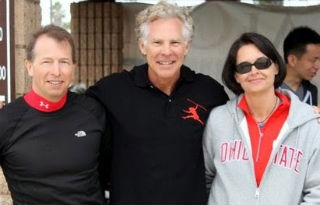 In Mark’s video “Under the Yellow Light” he talks about how adopting a Primal lifestyle can then make you want to take control of other areas of your well being – this suffocating urge for space was definitely a result of our new found relationship with ourselves. We had changed our bodies – now we were ready to change our lives.
In Mark’s video “Under the Yellow Light” he talks about how adopting a Primal lifestyle can then make you want to take control of other areas of your well being – this suffocating urge for space was definitely a result of our new found relationship with ourselves. We had changed our bodies – now we were ready to change our lives.
For several years we had been talking about, but always putting off, preparing our house for sale. The market wasn’t good, the weather wasn’t good, there were too many repairs to make and we couldn’t afford to do them. I’m a worrier and a planner…and I guess a procrastinator, if the first two get overwhelming. When we returned home from PrimalCon, we decided to finally move forward with the business of tackling all the things we had been putting off, whether they were easy or not. We wanted land and space, and to not feel like we were living in a fishbowl. I have always been a country girl trapped in the city. I didn’t grow up on a farm or really have any exposure to a farm, but I have always known intuitively that’s where I needed to be. I was never allowed to own an animal other than a dog, but as a child, I dreamed of owning a pet store where I could “play with and care for the animals all day” – what I didn’t realize then, but know now is that I simply wanted to be a farmer.
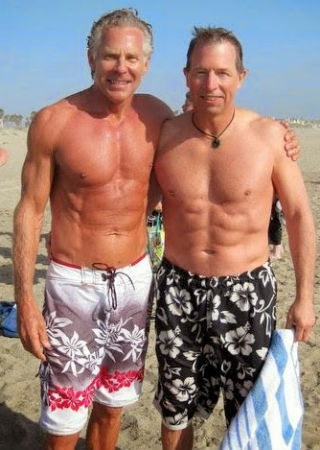 Naturally, the quality of our food had become a big issue since going Primal as well. Of course we tore through veggies and meat, but [we] yearned for the ability to produce our own. My husband is a chef by profession and good food has always been celebrated, savored, and enjoyed. Since my husband’s background is in the food service industry, we have more ability than some to target an area of the country where we’d like to live. We considered possibilities for his employment in Ohio all the way to the Virgin Islands (where he’d worked for years in the past). The island life was especially attractive anytime I’d had a few drinks while listening to some Kenny Chesney songs. Leaving it all with two young kids (both on the autism spectrum) and starting over down there would leave us financially strapped and probably not able to live any farmer type of life. So we set our sights on the southern states, near the coast.
Naturally, the quality of our food had become a big issue since going Primal as well. Of course we tore through veggies and meat, but [we] yearned for the ability to produce our own. My husband is a chef by profession and good food has always been celebrated, savored, and enjoyed. Since my husband’s background is in the food service industry, we have more ability than some to target an area of the country where we’d like to live. We considered possibilities for his employment in Ohio all the way to the Virgin Islands (where he’d worked for years in the past). The island life was especially attractive anytime I’d had a few drinks while listening to some Kenny Chesney songs. Leaving it all with two young kids (both on the autism spectrum) and starting over down there would leave us financially strapped and probably not able to live any farmer type of life. So we set our sights on the southern states, near the coast.
When Ed got a job offer in the panhandle of Florida, it felt like the perfect opportunity. We would be able to afford a couple acres of land AND be within 35 minutes of beautiful emerald water beaches. We had never been to or knew anyone in the Florida panhandle. The three hours the kids and I spent on the beautiful beach waiting for my husband to return from the job interview was the only introduction to the area I needed. This move required me exit my comfort zone more than I ever had in my entire life. A leap of faith that this was the right move for our family. My husband and I spent three long months apart as he had to start the job right away in Florida and I had to stay in Ohio with the kids and sell the house. That separation and stress was the biggest and toughest hurdle of the whole experience.

We will have lived here on Primal Acres Farm a year this October. The farming life has been everything I hoped and more. We go to bed every night tired as hell but with a new found sense of satisfaction and wake up in the morning well rested, content, and ready to tackle it all over again. The lows, when they happen are low…but the highs are so very sweet, personal, and fulfilling that the lows fade quickly. To sit on our porch swing at night with a glass of wine and be drowned out by the sound of singing frogs rather than turning up the TV volume because we can’t hear over the traffic noise is pure bliss. We were very lucky to find a property that had been a working farm in the past and already had all the infrastructure in place – water lines run, animal pastures, and a fenced quarter acre garden where the soil had been well cared for. That allowed us to do what they say you should not, which is jump headlong into everything. We had more projects started here in the first six months than some people get around to in the first five years. Yes, a farm really does tie you down – no longer do we have the ability to run off on several trips a year like we have in the past, heck going away for one evening seems like quite the obstacle at this point. The great thing is though that we live 35 minutes from the beach. We can do the AM animal chores, milk the goat, pack some drinks, and go for an early morning swim in the ocean. Have lunch at a beach restaurant and go home feeling like we’ve escaped to a different world for just a little while.

People shake their heads at us – You mean you bought a farm and you’ve never lived on one? Nope. Have you ever raised (insert – goats, chickens, turkeys, bees, rabbits, etc.) before? Nope. Have you ever had more than an 8×10 garden before? No… but we have all that now and more. We are learning by doing and living and having a damn good time figuring it out together. As Joel Salatin likes to say, “If it’s worth doing, it’s worth doing poorly the first time.” People are so afraid to try new things these days for fear of screwing them up – it’s so sad! You have to get out there and do, and fall, and fail, and stand back up and try again. Unlike me and bowling, you usually do get better the second round. I am good with animals, but it seems that neither my husband nor I was born with a green thumb. So we are experiencing a large learning curve when it comes to gardening on a larger scale and what does well in Florida vs. the way we use to grow things in Ohio. It is amazing what you can learn using Youtube and Google and I am currently enrolled in a local gardening class. Several times a day I look up how to videos or plant identification or post questions on homesteading forums. I am always amazed and grateful that others share their knowledge so freely.

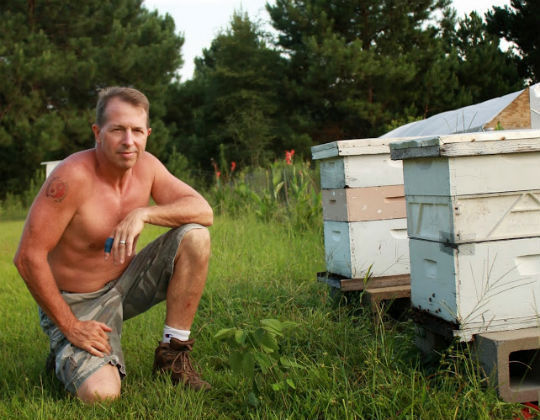
The goal is to eventually start selling enough things produced here on the farm that my husband can “retire” and stay home and work the farm. Hopefully his professional cooking and butchering skills can come into play by hosting classes for local folks and some other business ideas we are rolling around with. As it is right now, our weekends and evenings are overfilled with projects that require two people and his to-do list is always a mile long. I really wish I could afford to hire him on full time  One farm blogger I love wrote, “Sometimes I dream it’s Sunday and I wake up in a condo and the only thing I have to do is make coffee” – I totally get that now. As a child I thought, “Who wouldn’t want to live on a farm?!” But after my first couple days cleaning the chicken coop, I said to myself, “Yeah, I can see how this wouldn’t be for everyone.” The farm is a tough playground – no longer do I get to go to kickboxing class three times a week, but I feel like I walk miles everyday from one side of the farm to the other. The constant bruises on my legs, lack of fingernails, and scratches on my arms make me feel like a 10-year-old tomboy again. I lift 50 pound bags of feed instead of gym weights and feel like I sweat off quite a bit squatting in the garden. To workout after a day of working on the farm feels…very… laughable. We go to bed exhausted and sore but with a good sense of accomplishment. I’m glad I’ve never been one who enjoyed nightlife and party socializing, because socially, it’s isolating, mostly just by the sheer time it takes up. By the time chores are done for the evening and all animals have been wrangled away, a movie on Netflix seems like WAY too much of a commitment before bed.
One farm blogger I love wrote, “Sometimes I dream it’s Sunday and I wake up in a condo and the only thing I have to do is make coffee” – I totally get that now. As a child I thought, “Who wouldn’t want to live on a farm?!” But after my first couple days cleaning the chicken coop, I said to myself, “Yeah, I can see how this wouldn’t be for everyone.” The farm is a tough playground – no longer do I get to go to kickboxing class three times a week, but I feel like I walk miles everyday from one side of the farm to the other. The constant bruises on my legs, lack of fingernails, and scratches on my arms make me feel like a 10-year-old tomboy again. I lift 50 pound bags of feed instead of gym weights and feel like I sweat off quite a bit squatting in the garden. To workout after a day of working on the farm feels…very… laughable. We go to bed exhausted and sore but with a good sense of accomplishment. I’m glad I’ve never been one who enjoyed nightlife and party socializing, because socially, it’s isolating, mostly just by the sheer time it takes up. By the time chores are done for the evening and all animals have been wrangled away, a movie on Netflix seems like WAY too much of a commitment before bed.
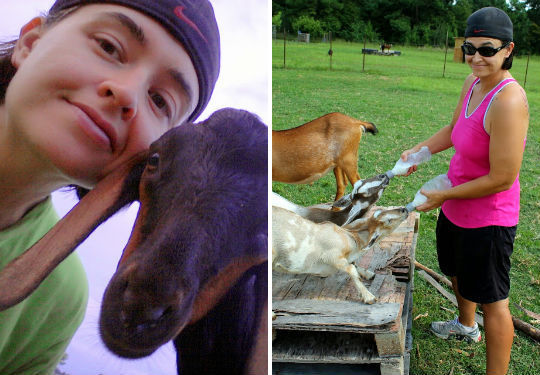
The family is doing very well here. My youngest son (who cried the first night we moved in because there were frogs on the window screens) is now chasing around chickens and participating in 4H projects. My older son (who is moderately autistic) is thriving with homeschooling and getting outside more than he did living in the city. He loves the beach and finds the ocean waves very calming and will stay out in them for hours. We gave up some conveniences and luxuries that we had living in a high tax suburb, but the ability to have a backyard bonfire, talk in outdoor voices outdoors, and own noisy animals is very freeing.

So, what I have learned so far is that farming is not for the weak, lazy, or squeamish (all biggies!). It’s a life lesson filled journey and an adventure where you pick up all kinds of interesting travelers along the way. Like the beat up day old chick I had to save from the bin at the feed store that now walks on her elbows and has another chicken as a bodyguard, the horse with ligament disease in his back legs that can’t be ridden which makes for an expensive lawn ornament, and the turkey named “Lucky” that has been pardoned from Thanksgiving and follows me everywhere like a puppy. Every single one of them serves a purpose and teaches you something. The people we have met so far have been wonderfully helpful and kind. Each sharing with us their knowledge and expertise to make our lives easier. Amazing how finding like-minded people can make you feel so much less crazy. Primal living has changed our lives in so many positive ways I can’t even fathom where we’d be right now had we not taken those first steps toward change. I am truly blessed and grateful that I am on this path today.
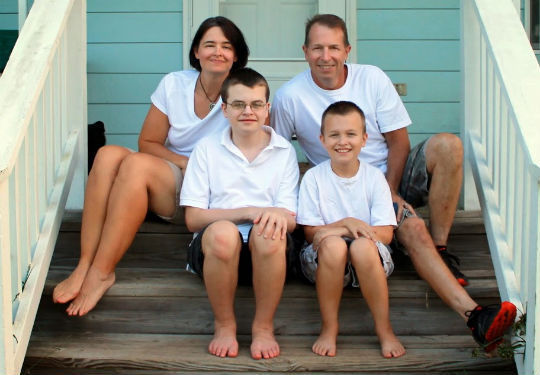
Come check us out on Facebook, or Instagram – We are just getting started over here! 
Amy
Join Mark Sisson and Friends in Sunny Southern California this Sept. 25-28! Get Your Tickets for PrimalCon Oxnard 2014 Today and Finally Meet Your Tribe!




August 14, 2014
Would Grok Work Overtime?
 There’s that infamous question interviewers often ask job candidates to try to catch them off guard: “Name one of your negative qualities and talk about how it’s played out in the workplace.” Some people end up stunned by the question and stammer their way through some off-the-cuff remark they hope isn’t too fatal. Others, however, heard about some version of this question on LinkedIn or from their best friend’s girlfriend’s cousin down at 31 Flavors and spent days strategizing an answer: “Crap – what could I say that might satisfy the committee but not make me look bad?” I’d venture to say a sizable percentage of these folks settle on “confessing” their overcommitment to their jobs and a minor penchant to overwork. After all, what could be more endearing, right? What could make us look better in an interview or even a social venue than to come across as being diligent, virtuous and important enough to work as much as possible? (So says the dominant culture anyway.) We pay a price for this virtue, however. A recent survey suggests that more than half of us are stressed out over our work situations. Research demonstrates that Americans are working more hours than they have in decades since national statistics were regularly gathered. Likewise, we’re apparently working more than our counterparts in the rest of the industrialized world. (There’s a bummer of a fact for you.) If Grok were a fly on the wall…
There’s that infamous question interviewers often ask job candidates to try to catch them off guard: “Name one of your negative qualities and talk about how it’s played out in the workplace.” Some people end up stunned by the question and stammer their way through some off-the-cuff remark they hope isn’t too fatal. Others, however, heard about some version of this question on LinkedIn or from their best friend’s girlfriend’s cousin down at 31 Flavors and spent days strategizing an answer: “Crap – what could I say that might satisfy the committee but not make me look bad?” I’d venture to say a sizable percentage of these folks settle on “confessing” their overcommitment to their jobs and a minor penchant to overwork. After all, what could be more endearing, right? What could make us look better in an interview or even a social venue than to come across as being diligent, virtuous and important enough to work as much as possible? (So says the dominant culture anyway.) We pay a price for this virtue, however. A recent survey suggests that more than half of us are stressed out over our work situations. Research demonstrates that Americans are working more hours than they have in decades since national statistics were regularly gathered. Likewise, we’re apparently working more than our counterparts in the rest of the industrialized world. (There’s a bummer of a fact for you.) If Grok were a fly on the wall…
The problem is our work “ethic” might not be quite as effective as we think, and I don’t think Grok would be surprised here. Not only do overworked employees get sick more often, but they’re significantly more likely to experience depression (21% overworked employees versus 8%) and have a much higher injury hazard in the workplace (61% higher in workers who did overtime) (PDF). More than a third of people who overworked described themselves as being highly stressed (compared to 6% who did not overwork), stress, of course, having an annoying way of impeding cognitive functions like short-term memory, creative thinking and emotional regulation. Check out this fun infographic. Sound familiar?
Just this week, The Atlantic had an article on the issue of work hours, “To Work Better, Work Less” in which they took on the cult of overwork. While some people put in an unhealthy number of hours because they’re working multiple jobs to pay their basic bills, others are on more of an obsessive quest to over- and out-perform even when additional hours did nothing for their actual productivity. In fact, overworking costs companies exorbitantly each year in sick time, bigger health care costs, higher turnover and lost productivity (PDF). Regardless of the actual consequences, inherent to the culture of overworking, The Atlantic authors suggest, is the “moral” dimension we assign to diligence. Our hours become a symbol of how righteous we are, and we give up life balance, family closeness, social connection and even basic health in the interest of that belief.
The Primal perspective on all this, of course, is the observation that we’re incessant experts at contorting our own nature. In fact, we take great pride and maybe even our collective human identity in the fact that we, unlike “lower” beasts, can manipulate ourselves with sheer will and vision. But vision for what? Our grand schemes almost always come at a price, and much of the time it’s not worth the payment. In the case of overworking, I think the price is a continual devaluing of physical health, personal leisure, entertainment, travel, sleep, peace, hobbies, and – that traditional well of creative genius – boredom.
On the health front, sure, there’s the trend toward treadmill desks and other activity tools that keep us moving, thereby ameliorating the effects of sedentary hours. As much as I wholeheartedly support these inventions (and make sure people in my own company have access to them), I’m wary that the devices then can become justification to perpetuate the same mistaken push toward relentless human efficiency. I love a good tip here or hack there that allows me to get more done in less time or with less tedious effort, but the ultimate point is to be happier rather than more productive.
There’s a very real reason I included “Be Selfish” among the “Habits of Highly Effective Hunter-Gatherers.” Of course, our ancestors worked together and every individual needed to pull his/her weight. The fact is, anyone could be more or less voted off the island at any given time. That said, nobody benefited from a band of exhausted, sick, edgy and agitated people who didn’t have what it took to care for their children or get along. Surely, the “selfish” habit has been the most controversial of the list and the one about which I get the most feedback. Nonetheless, I think it’s one of the most important. Many of the rest follow from that concept and all it makes space for. The fact is, it can be genuinely hard to go against the cultural grain and claim sanity for yourself. Oftentimes, people whose motors go the most have little patience for those whose energy is more balanced. I’m personally suspect of people who won’t allow themselves to take a real vacation, for example and of those who won’t allow their employees to enjoy genuine downtime. I just don’t buy the truth they’ve hung their hat on, and neither does science.
I consider myself fortunate to be able to work in a field I love, doing work that offers me genuine meaning and connection. That said, my life isn’t my work, and I wouldn’t want it to be. Once upon a time, it was that way for me, and the anvils of deteriorating health and mental stress finally got through to my brain: this wasn’t working for me. I genuinely feel for those who are cobbling together money at multiple jobs, and it’s constantly an hours game. When we have the choice, however, we can and should do better for ourselves.
I think, on some level for many people in a position to choose, the pattern can become self-perpetuating. Some folks, for example, manage to leave a position with unreasonable demands only to go recreate the same situation for themselves elsewhere. It’s like they adapt in a dysfunctional way to certain level of chaos and grope for that homeostasis. It becomes an artificial set-point against which they gauge their lives. Rather than give themselves time for this awareness to come, they react against the void. Sometimes people don’t have enough patience with their own process to allow their personal motors to recalibrate, for their minds to envision and embrace all that they could do with that free time.
We all have this essential instinct that yearns to be applied for our own balanced well-being and personal thriving. Time is our ultimate Primal capital. We’re stewards of our own life energy. How would Grok have invested his, and what would he be thinking in your shoes right now?
Thanks for reading today, everyone. I hope you’ll share your thoughts and feedback. Have a great end to the week.
Join Mark Sisson and Friends in Sunny Southern California this Sept. 25-28! Get Your Tickets for PrimalCon Oxnard 2014 Today and Finally Meet Your Tribe!




August 12, 2014
How to Safely Expose Your Kids to Dirt
 If you’ve been reading this blog for any reasonable stretch of time, you know that I’m a big proponent of getting dirty. By overvaluing sterility and fearing dirt – in our homes, our guts, even our hospitals – we’ve impaired our immune systems, our gut and digestive health, and even our mental health. The world is a dirty place, and we need to accept that. We need to embrace it, within reason, especially if we’re wards of tiny still-developing humans for whom exposure to dirt has important and resounding benefits. You’ve got the benefits to current and future immune function that I’ve gone over in the past. Then you’ve got soil-based microbes like Mycobacterium vaccae, which increase serotonin levels and may be responsible for the positive disposition that seems to be universal among hobby gardeners. It’s probably why kids have a natural inclination to engage with the ground, get handsy with the soil and make out with mother nature. I say we let them.
If you’ve been reading this blog for any reasonable stretch of time, you know that I’m a big proponent of getting dirty. By overvaluing sterility and fearing dirt – in our homes, our guts, even our hospitals – we’ve impaired our immune systems, our gut and digestive health, and even our mental health. The world is a dirty place, and we need to accept that. We need to embrace it, within reason, especially if we’re wards of tiny still-developing humans for whom exposure to dirt has important and resounding benefits. You’ve got the benefits to current and future immune function that I’ve gone over in the past. Then you’ve got soil-based microbes like Mycobacterium vaccae, which increase serotonin levels and may be responsible for the positive disposition that seems to be universal among hobby gardeners. It’s probably why kids have a natural inclination to engage with the ground, get handsy with the soil and make out with mother nature. I say we let them.
But we have to do it right. There’s good dirt and there’s bad dirt. And sometimes the good dirt can be contaminated with bad stuff. We must then promote reasonably safe exposure to dirt. How so?
Let them play in the dirt. Don’t lose your mind if they eat a teaspoon or two (you don’t have to provide actual teaspoons). Encourage mud puddles, or “muddles,” to facilitate greater surface coverage. Actually, encouragement is unnecessary, as kids naturally gravitate toward mud and dirt.
Avoid triclosan handsoaps. Triclosan is an anti-bacterial agent, an antibiotic. It kills some bacteria but promotes antibiotic resistance in those who survive. And don’t forget that we have commensal/beneficial bacteria on our skin that help keep out the pathogens. If triclosan clears a path through those guys, the pathogens can gain a foothold. Plain soap and water are all you need.
Avoid excessive handwashing. If you live in a place like Karachi, Pakistan, where open sewers run through slums, fastidious handwashing can improve child well-being and overall health. I’m not so sure the obsession with handwashing in the relatively pristine environments of more industrialized nations is warranted, and I suspect it’s counterproductive. A little dirt under the fingernails rarely hurt anyone.
Test your soil for contaminants. Soil can harbor heavy metals like lead, arsenic, and Viking death metal (sorry, terrible subgenre joke that my employees insisted I include). I wish I could make broad pronouncements about soil in general, but I cannot; heavy metal content varies widely from country to country, state to state, town to town, and even backyard to backyard. Older houses may be more likely to have lead due to deteriorating lead paint. Do a search for “soil heavy metals [your town]” to find information about your specific area. Another option is to actually test your soil for heavy metal contamination; this is a good guide for taking soil samples.
Pick up dog, cat, and wild animal poop regularly. “Poop is everywhere” is one of those factoids that people love telling to other people. But microscopic amounts of fecal matter are one thing. Full-on turds are another. Also, wild animals like raccoons (who whether you see them or not are probably near you) almost uniformly carry a deadly parasite that can trigger dangerous inflammation in children. In case you haven’t gotten on board yet, feeding a raw prey-model Primal pet diet to your cats and/or dogs has the benefit of making the poop easier to clean up.
Weed using non-toxic approaches, like your hands, boiling water, or vinegar. In previous posts, I’ve discussed the downsides of weed control using Roundup, the glyphosate-based herbicide that inhibits the shikimate pathway in both plants and bacteria (but not mammals). Since we mammals rely on bacteria in our guts to maintain and promote good health, however, Roundup hits us indirectly. The whole idea of dirt exposure in kids is to “seed” them with beneficial bacteria, so spiking their dirt with a bunch of bacteria-killing Roundup with a half-life in soil of nearly 100 days (PDF) is counterproductive. A little elbow grease, a big pot of boiling water (maybe two big pots; watch for errant kids), and/or some white vinegar directly applied to the weeds will take care of them without putting your kids in harm’s way.
Favor “pesticide-free” parks. Public parks are a great place for kids to play, run around, get dirty, meet each other, and generally act like kids. But if they’re going to be playing with, in, and around the dirt – and they will be – focus on parks whose grounds aren’t doused daily in pesticides. Eugene, Oregon has a “pesticide-free parks” program, and I imagine other places do, too. Look around for similar lists in your area. Barring that, contact your city officials and make a list yourself.
Sampling is normal, but gorging is suspicious. If a kid is chowing down on dirt, really savoring the soil, and displacing actual food, something’s up. You might need to take a closer look at his diet and look for egregious nutrient deficiencies. Some candidates:
Calcium: Calcium deficiency may be linked to pica/geophagy, so unless your kid is willing to eat loads of spinach, consider adding in some high quality pastured dairy (yogurt, cheese, whole milk; try alternate animals, too, like goat or sheep) for some really easy calcium.
Iron: Iron deficiency or depletion has also been linked to pica. Rather than resort to a supplement (which can be constipating and poorly absorbed), introduce liver to your kid. This is the perfect time, in fact, because little kids’ palates haven’t been corrupted by gentile society. I mean, the kid’s eating dirt. I’m quite certain he’ll give pastured chicken (the type highest in iron) liver a chance. Daily egg yolks are also a good, palatable, easy to disguise option for iron, not to mention all the other important nutrients they provide.
Zinc: Zinc deficiency is also linked to pica. Oysters are probably the densest source of zinc, but red meat, cashews, and pumpkin seeds are also good sources. If you trust the oyster purveyor, there’s nothing like a toddler slurping down a raw one.
Get a furry pet. Cats and dogs have different effects. While I like cats (even though they’d kill us all if they weighed as much as a yellow lab), dogs seem to be more beneficial to overall immune development in children. In one study, cat exposure in early childhood had no effect on atopic dermatitis, but dog exposure was protective. In another, early dog exposure led to big improvements in general resistance to colds; cat exposure was also protective, but less so. However, a 2008 study found that cat exposure was protective against asthma while dog exposure was not. What do we make of it? If I had to guess, I’d say having both a cat and a dog would be most protective against the broadest range of immune disorders.
Be careful about cat litter, especially if you allow your cats outdoors. Outdoor cats who hunt rats may carry the Toxoplasma gondii parasite, which your kid (or you) can pick up when handling cat litter. T gondii has been linked to depression and suicide. (And if your kid happens to be a rat, the parasite will abolish all fear of cats, make cat pee irresistible, and probably lead to his or her gory death.) Even if your cat doesn’t have the parasite, cat litter isn’t going to impart many beneficial microbes and as such should be summarily avoided. You’re not missing out on anything by not sprinkling crumbled cat poop in your smoothie.
Go on lots of hikes, go camping, and play in creeks, streams, and rivers. The backyard is great (and is a great way to introduce tent camping, in fact). It’s handy, it’s right back there, and it’s safe. But it’s not enough. There’s an entire world of dirt that’s just begging to be traversed on all fours. For optimal dirt exposure, take your kid out to the great outdoors. Go on hikes. Pause to look for anthills and interesting fungi. Tramp through creeks. Pause to look for crawdads and tadpoles. Visit deserts, redwood forests, swamps, rainforests. Wherever you are, you don’t even have to make sure your kids “get sufficient dirt.” They’ll find each other.
As you can see, most of the advice is common sense. It’s mostly “let your kid do what kids will” and “but be reasonable about it.” Soil smoothies and cat poop snacks, bad. Mud mustache and a little dirt under the fingernails, probably okay.
That’s all I’ve got today, folks. I hope it was helpful to all you parents out there. Even if you’re not a parent or kid, this stuff works on adults, too. So get to it!
Join Mark Sisson and Friends in Sunny Southern California this Sept. 25-28! Get Your Tickets for PrimalCon Oxnard 2014 Today and Finally Meet Your Tribe!




August 11, 2014
Dear Mark: Two Weeks Off Primal, Pili Nuts, Fasting and Micronutrient Deficiencies
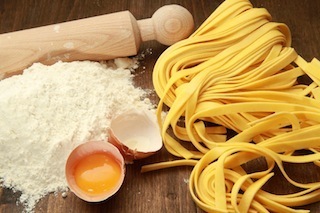 In today’s edition of Dear Mark, I cover three questions from readers. First is from Richard, who’s taking his father back to the old country – Italy, to be exact – for a two week vacation to visit the place of his birth where he’ll be immersed in pasta, sweets, and liquor and completely at the mercy of his hosts. What should he do? Second, what’s the deal with pili nuts? Are they worth including in a Primal way of eating? And finally, a reader is worried about nutrient deficiencies when fasting. There’s really nothing to worry about as long as you’re reasonable about your fasting habits, and I explain why below.
In today’s edition of Dear Mark, I cover three questions from readers. First is from Richard, who’s taking his father back to the old country – Italy, to be exact – for a two week vacation to visit the place of his birth where he’ll be immersed in pasta, sweets, and liquor and completely at the mercy of his hosts. What should he do? Second, what’s the deal with pili nuts? Are they worth including in a Primal way of eating? And finally, a reader is worried about nutrient deficiencies when fasting. There’s really nothing to worry about as long as you’re reasonable about your fasting habits, and I explain why below.
Let’s go:
Thank you for the great public service you provide!
I’ve happily followed a Primal lifestyle for nearly two years and feel great on it.
Now, I’m considering taking my father back to the small Italian island where he was born for about two weeks. This would mean an unavoidable break from Primal food – it would be a sugar and grain fest of pasta, sweets and liquor. Opting out would be rude to our hosts, difficult to explain and not feasible (there simply won’t be many alternatives as I won’t be self-catering at all).
Will all my Primal gains be lost? Before going Primal I lived on such a regimen and although I didn’t thrive on it, it didn’t destroy me either.
Will two weeks of anti-Primal living be worth it?
Richard
Yes. It will absolutely be worth it.
Being Primal, as you say yourself, is a lifestyle, not just a way of eating. Eating informs it but does not entirely define it.
Let’s see what a couple weeks spent in the company of your father in his ancestral homeland on the beautiful Mediterranean off the coast of Italy has to offer in the way of non-dietary lifestyle – and therefore health – enhancements:
Sunshine. It’s probably going to be sunny the entire time you’re there without being overly hot. You’ll fill up on vitamin D. You’ll be in a great mood and you’ll sleep well because you’ll be exposed to tons of bright, natural light during the day (which will set your circadian rhythm).
Community. You’re going to be socializing the entire time: big lunches, late dinners, flowing wine, laughs, old times recounted. Italian culture is well-known for supporting close-knit, strong communities, and this has been associated with multiple health benefits, including protection from heart disease and deaths from all causes. Partake. Gorge yourself on community. You’re only there for a couple weeks, so make the most of it.
Gratitude. You’ll be with your father. You know, that guy who gave you life, reared you, and provided the solid foundation you’ve used to become the man you are today. We owe a lot to our parents – and they to us – and this trip is a fantastic way to give thanks and show gratitude. And you may not know this, but giving gratitude has proven physiological health benefits. Hey, it’s almost like we’re meant to be around people who support us and deserve our gratitude.
And even the food isn’t as bad as you’re thinking. It’s probably going to be well-made, handcrafted with love and artisanship. The food will be fresh. There will be pasta and bread and sweets, yes, but it’ll be the highest quality possible (if you have a choice, go with risotto (rice) or polenta (corn) instead of pasta). Everything will be cooked in olive oil or butter, I’d imagine. These aren’t vegetarian cuisines, so you’ll have plenty of meat, good cheese, and charcuterie, plus whatever fresh produce is in season. Just eat a little less of the pasta, bread, and sweets and eat a little more of the meat, cheese, charcuterie, and produce. And since you’re on an island, you’ll have access to fresh seafood.
Will your gains be lost? I doubt it. If you end up eating more carbs (or food overall) than you’re used to eating, you can offset the hits to your fat-burning efficiency by increasing your activity levels. That could be going for a long walk every day, swimming in the brilliant blue sea, doing body weight workouts, running hill sprints a couple times a week, or anything that you feel like doing. It will all upregulate your substrate oxidation machinery.
If you’re coming from a ketogenic diet or something super low carb, you might have to endure a mini (re)induction period when you return. But it shouldn’t be anything devastating.
Hi Mark,
I guess you never received my question, on whether Pili Nuts that only grow in the Philippines, are considered primal. Bummer )-:
Ah, it must have flown under my radar. Sorry about that. Let’s take a look and rectify the situation, though, huh?
Pili nuts are definitely a good choice. Fat-wise, they’re more saturated than any other nut I’ve seen with almost 9 grams of saturated fat per ounce. The rest is monounsaturated, with a small amount of polyunsaturated fat. According to a recent article in the Wall Street Journal, an ounce of pili nuts also has almost 100 milligrams of magnesium (more than any other nut) and 69% of the daily allowance for vitamin E (probably because these nuts are grown in Southeast Asia, the Phillipines, and Papua New Guinea and need to protect their fatty acids from the warm, humid climates; it’s always fun to co-opt a plant’s natural defenses for ourselves!).
No formal research has been done on the health effects of pili nut consumption, but based on the nutritional profile I think we can assume they’d be positive. Go for it.
Hi Mark!
I will be brief

I read your fasting articles and they are wonderful, but I have a quick question that I don’t think you answered:
What about the daily recommended USDA intake for vitamins, minerals, etc.? Wouldn’t a 24 hour fast leave us “malnourished” during that day and stop the normal body functioning? (I understand that skipping the calories is fine, as we have enough reserves.)
Thanks!
Angel
It’s possible to become malnourished from excessive caloric restriction, sure. Long term anorexics tend to have multiple nutrient deficiencies for the simple reason that they aren’t eating enough food. And in a recent study, obese subjects ended up deficient in a variety of micronutrients after following an 800-calorie-a-day diet for 12 weeks. But these are rather extreme examples of caloric restriction that I trust (and hope) you aren’t following.
Intermittent fasting is different. It’s, well, intermittent, rather than drawn out. Acute, not chronic. The occasional lapse in eating, not a constant state of lacking that tugs at your nutrient stores. If you’re doing 24 hour fasts, you’re doing them once, maybe twice a week, and eating relatively normal amounts of food the rest of the week.
Fat-soluble vitamins, like D, A, E, and K are stored in your body fat and liver, so day to day intake fluctuations shouldn’t impact your stores of those nutrients. And because you’re already eating a ton of fat-soluble vitamins (from offal, pastured animal products and meats, egg yolks, leafy greens, the occasional handful of nuts) and getting adequate sunlight (or taking vitamin D), you’ll have plenty saved up.
Water-soluble vitamins, like C, the Bs, and folate need to be eaten more frequently, but skipping a day doesn’t make a difference. Full blown avitaminosis disorders like beriberi (thiamine deficiency), pellagra (niacin deficiency), night blindness (vitamin A deficiency), anemia (iron or B12 deficiency), hypothyroidism (iodine deficiency), scurvy (vitamin C deficiency), or rickets (vitamin D deficiency) take a long time to manifest. A missed day here or there won’t matter as long as your overall diet is replete in nutrients. Evaluate your nutrient intake using a longer timescale.
If you’re still worried, you can always pop a quality multivitamin, or take specific minerals or vitamins that you suspect your diet lacks.
That’s it for this week. Thanks, everyone!
Join Mark Sisson and Friends in Sunny Southern California this Sept. 25-28! Get Your Tickets for PrimalCon Oxnard 2014 Today and Finally Meet Your Tribe!




August 10, 2014
Weekend Link Love – Edition 308
 Episode #31 of The Primal Blueprint Podcast is now live. I hang out with Jimmy Moore to talk about his new book, Keto Clarity, and the wide array of health benefits a ketogenic diet can offer. If you have any ideas for future podcasts, please let us know by using the blue “Submit a Question” button in the sidebar!
Episode #31 of The Primal Blueprint Podcast is now live. I hang out with Jimmy Moore to talk about his new book, Keto Clarity, and the wide array of health benefits a ketogenic diet can offer. If you have any ideas for future podcasts, please let us know by using the blue “Submit a Question” button in the sidebar!
This guy’s taken it upon himself to record himself doing each of the Primal Blueprint Workouts of the Week. He’s up to number 7 so far.
Research of the Week
A cool (but also depressing) paper explores all the possible ingredients, additives, and accidental contaminants in our food that could be making us fatter.
The more stressed out you are, the longer it’ll take to recover from your workouts.
Among a cohort of women, aged 25-64 and living in southern Sweden, sun avoidance increased the risk of all-cause mortality.
Neonicotinoids really, really hate bees. In new research, the pesticides inhibited the ability of bee mitochondria to generate energy.
Interesting Blog Posts
How to undo the damage to your body caused by sitting.
Gardening makes you happy, especially if you get really dirty.
Media, Schmedia
Lebron James has gone low-carb to slim down. If former teammate Ray Allen had any input on the situation, he’s probably gone Paleo, too. “In Whole Foods, I kill the fruit and vegetables section.”
I’m all for bacon and Crossfit, but this seems unnecessary.
Everything Else
Should hospitals really strive for maximum sterility?
Hardboiled eggs are changing the lives – and health – of rural Rwandan kids. Too bad about all that cholesterol, though.
Denise Minger talks about the failures of the food pyramid and makes some recommendations for correcting them.
Ever think about striking out and living off the land? These people are actually doing it.
Monsanto really will stop at nothing.
How Coca-Cola is responding to the growing awareness among, well, everyone that Coke is terrible for your health.
I’d eat it.
Companies are rebranding bugs to make them cuter and more appealing to squeamish consumers. “Sky prawns” is my favorite.
Recipe Corner
If you’re worried about the quality of the bacon you eat, why not just make your own?
Sweet potato pancakes, so healthy and nutrient-dense that they absolve you of all potential guilt.
Time Capsule
One year ago (Aug 10 – Aug 16)
You Are What Your Mother and Father (and Grandmothers and Grandfathers) Ate – The reverberation of our choices are trans-generational.
7 Things You May Be Doing That Impair Workout Recovery – If you’re a hard-charging athlete – or even if you’re not – watch out for these.
Comment of the Week
Instead of passing acquaintances with a wave and a hello I’m going to try and stop and ask, ‘How are you?’ (and listen to the reply!)
-You know, I really like this idea.
Not a Subscriber? You Are Missing Out. Subscribe for Free Today and Instantly Get 8 Primal eBooks and So Much More!




August 9, 2014
Asian Salmon Burger with Homemade Pickled Ginger
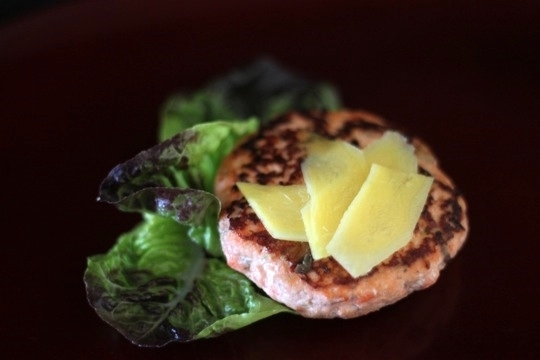 If you like the spicy, vinegary bite of pickled ginger, then it’s a condiment you easily could, and should, make at home. Scan the labels of pickled ginger next time you’re at the grocery store and you’re likely to find ingredient lists that include artificial pink dye, aspartame or lots of sugar.
If you like the spicy, vinegary bite of pickled ginger, then it’s a condiment you easily could, and should, make at home. Scan the labels of pickled ginger next time you’re at the grocery store and you’re likely to find ingredient lists that include artificial pink dye, aspartame or lots of sugar.
Using three ingredients at home – ginger, rice vinegar and honey – and a very simple method, you can make your own pickled ginger in about 20 minutes. Give it another 24 hours for flavor to develop and the pickled ginger is ready to eat. It keeps almost indefinitely, so just stash it in the refrigerator door with your other refrigerated condiments.
Besides sushi, what else can pickled ginger be used for? Toss it into a glass of sparkling water, chop it up into a fruit salad or green salad, use it as a topping for tamari marinated steaks or burgers, mix it with shredded cabbage and avocado, or, use it as a garnish for these Asian Salmon Burgers. Made without any added filler or binder (like breadcrumbs or eggs), these salmon burgers are moist and juicy with pure wild salmon flavor. Shiitake mushrooms, green onions and coconut aminos add extra flavor that pairs perfectly with a mound of pickled ginger on top.
Note that this recipe uses a lot less sweetener than most recipes for homemade pickled ginger do. The result is ginger with a slightly bolder, spicier, more intense flavor.
Servings: 6 burgers
Time in the Kitchen: 45 minutes, plus 24 hours to pickle the ginger
Ingredients:

5 ounces ginger root (150 grams) (equal to about 1 cup of very thinly sliced ginger)
1 cup unseasoned rice vinegar (240 ml)
2 tablespoons honey (30 ml)
1 1/2 pounds boneless skinless salmon cut into 1-inch cubes (680 g)
12 fresh shitake mushrooms, finely chopped
1 garlic clove, finely chopped
4 green onions, finely chopped
3 tablespoons coconut aminos (45 ml)
1/2 teaspoon kosher salt (2.5 ml)
Instructions
Ideally, make the ginger at least a day before you plan to eat it. The pickled ginger will keep for months or more in the refrigerator.
Peel the ginger then shave it into very thin pieces. To do this, use a mandoline, vegetable peeler and/or sharp knife. You should end up with about 1 cup of shaved ginger.
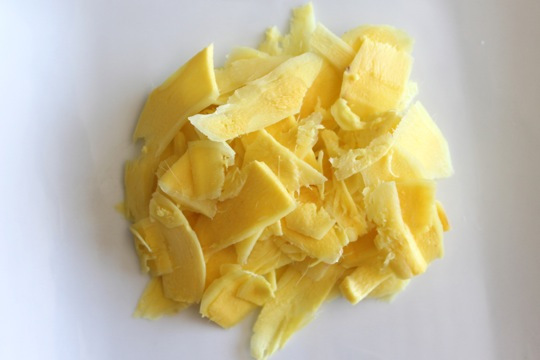
Whisk together the vinegar and honey in a small bowl or jar.
Bring 2 cups of water to a boil. Add the ginger, and blanch for 2 minutes. Drain, and transfer ginger to the bowl with the vinegar and honey. Let cool then cover and refrigerate in its brine.
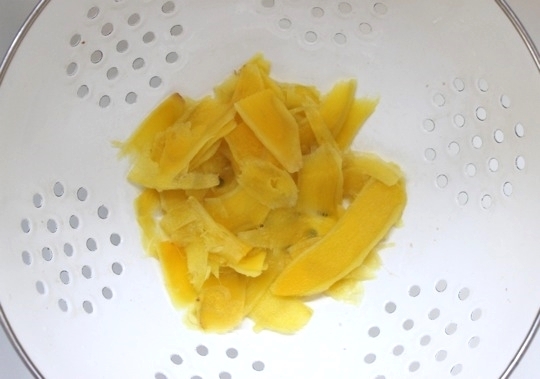
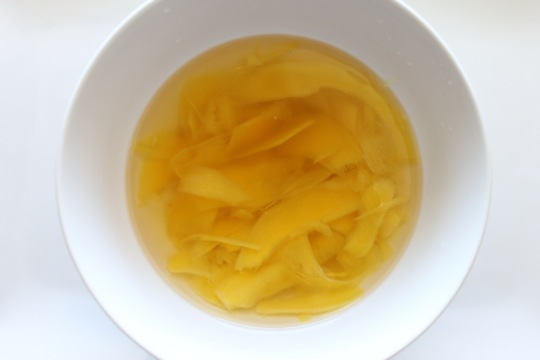
To make the salmon burgers, first sauté the mushrooms and garlic over medium heat in a little bit of oil until the mushrooms are lightly browned and most of the liquid has evaporated, about 5 minutes.
Place 1/4 of the salmon pieces in the food processor and blend until it’s a smooth paste. Add the rest of the salmon, mushrooms and garlic, green onions, coconut aminos and salt. Pulse, stopping to mix and scrape down the sides, until the salmon pieces are about 1/4-inch/6 mm in size. Don’t process the salmon so much that it all becomes a smooth paste; it should be a little chunky.
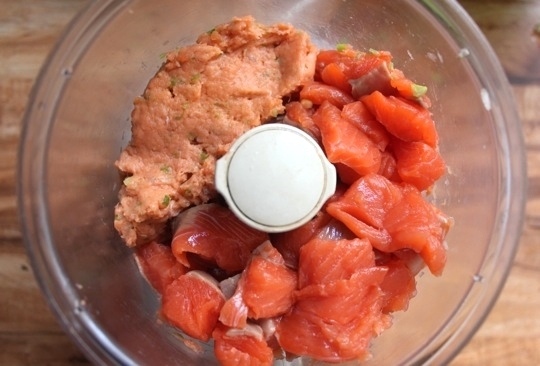
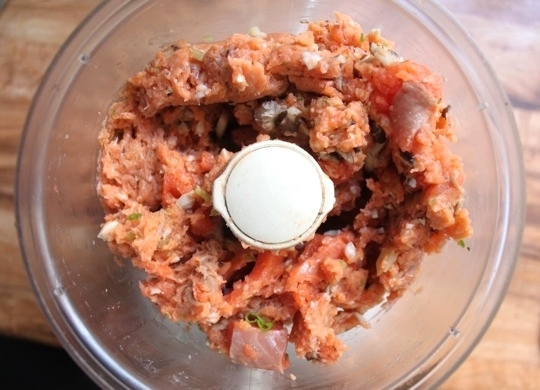
Shape into 6 patties.
Heat a few tablespoons of oil in a skillet over medium-high heat and cook for 3 to 4 minutes a side, until there is no raw, dark pink salmon in the middle.
Serve on a bed of lettuce and top with pickled ginger.

Not Sure What to Eat? Get the Primal Blueprint Meal Plan for Shopping Lists and Recipes Delivered Directly to Your Inbox Each Week




August 8, 2014
Sick and Tired of Feeling Sick and Tired
It’s Friday, everyone! And that means another Primal Blueprint Real Life Story from a Mark’s Daily Apple reader. If you have your own success story and would like to share it with me and the Mark’s Daily Apple community please contact me here. I’ll continue to publish these each Friday as long as they keep coming in. Thank you for reading!
 I want to begin by thanking you so much for what you are doing to help people, and for such an impeccable website and thorough information. I enjoy being a part of the community and gleaning so much good information every day!
I want to begin by thanking you so much for what you are doing to help people, and for such an impeccable website and thorough information. I enjoy being a part of the community and gleaning so much good information every day!
I have always been conscious of what I put into my body. Conscious, not strict. I have never smoked a cigarette, and I haven’t eaten fast food in probably 10 years. I also managed to stop drinking soda a while back. But, like everyone, I made plenty of mistakes (I also still make them – but, ya know, slightly fewer now). Unfortunately, the majority of those were from being mis- or un-informed. Though some of them were just from being human and hungry!
As long as I can remember, I had allergies: to cats, dust, plants, changes in weather, stupid people. I also, even though I have never been obese, had very high cholesterol. And, of course, I was prescribed medication. The military was adamant about those wonder-drugs we all know as statins. Bouts with depression, upset stomach and heartburn, frequent illnesses, etc., were all met with medication. But I was sick and tired of feeling sick and tired all the time, and was determined to find out why that was. I tried to be healthy and improve myself as much as I could. I exercised when I could and ate well when I could, eventually going organic to minimize chemicals in my body. I felt a bit better but was still unsatisfied; something wasn’t altogether right. At one point I finally decided to get rid of medications and really clean myself out. At the same time I had gotten into “juicing” (vegetables, not circa 1980s steroids). This cleanse changed my life. And cleanse is the right word.
Such a big change to your body and lifestyle can be potentially dangerous, so I was careful to ingest as much information as I could to make sound decisions. I was also looking into the vast amount of information on the Paleo diet and “living primally.” I immediately cut out grains, sugar, and dairy. I weaned myself off medications slowly. I began by adding freshly squeezed juices to my diet rather than fasting. This made it easier to slowly reduce the “bad stuff” rather than going “cold turkey.” But even then, the change to my body was noticeable. To be honest, I felt fairly terrible for a little while. But then… then it all changed. Suddenly, I felt better. A lot better. I was reading similar stories all over the Internet about people experiencing the exact same thing (hello, Mark’s Daily Apple). Eventually, my workouts showed vast improvement and I felt like doing more (hello, CrossFit). I was energized and strangely, not getting sick… at all. I wasn’t terribly strict with the diet, but the few times I ate “badly” I paid for it. That realization really cemented the idea that my food was such a major factor in my health and that my ideas about food were terribly misled. My life improved drastically in many ways. I became sharper mentally, and as my body became stronger and more to my liking aesthetically, I became happier emotionally.
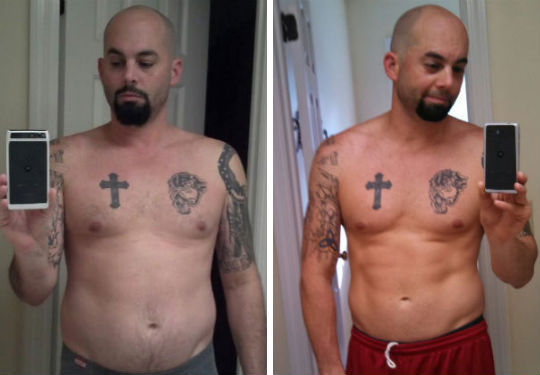
At this point I started ribbing the hell out of my friends and family. Like an evangelist, I spread my “gospel.” And guess what happened? Well, actually, I was met with a lot of resistance! But it didn’t stop me and, lo and behold, others around me began enjoying the same benefits. Friends and family eventually came around. I found it helped not to push people, but rather give them the information and/or the means to get it (hello again, Mark’s Daily Apple) and let them figure it out on their own. My mother, who had struggled with high blood pressure for three decades, felt a little faint. She went to the doctor to find her blood pressure was too low. Because of her medication. Her doctor was astounded (yes, her doctor, of many years, was astounded that changing her diet lowered her blood pressure… nobody’s perfect). I, several family members, and many friends have now come completely off of all, or most, medications. We are much more fit, much more energetic and productive, and will probably enjoy many more years of life than we would have previously. It has been almost two years for me and – I know this seems improbable, but – I have not been sick, or had any allergic reactions… at all. Not even a sniffle. Well, maybe a couple of sniffles… but then, nothing. My immune system is no longer suppressed by the intake of toxins! I fight off any hint of illness before it starts. And this is someone who got sinusitis and/or bronchitis a couple of times every year. (Disclaimer – please do not adjust your medication without a doctor’s approval. Also, I am not claiming these results are possible for everyone. We are all different.)
 Since then, I have continued to research health, fitness, and nutrition. I have really tweaked my diet and exercise to a place that is very near optimal for me. I even suffered a pretty serious injury and recovered faster and better than anyone – myself – thought. People come out of the woodwork and ask me about food and exercise because it is obviously such a prevalent part of my life. I converse with members of MDA in the forums and comments and with others elsewhere. I see information like this all over the world making changes in people’s lives. And those things continue to change my life.
Since then, I have continued to research health, fitness, and nutrition. I have really tweaked my diet and exercise to a place that is very near optimal for me. I even suffered a pretty serious injury and recovered faster and better than anyone – myself – thought. People come out of the woodwork and ask me about food and exercise because it is obviously such a prevalent part of my life. I converse with members of MDA in the forums and comments and with others elsewhere. I see information like this all over the world making changes in people’s lives. And those things continue to change my life.
The Primal Lifestyle is not a fad, nor a “diet” that “really works.” It is simply one of the best possible ways to be healthy: the way we were intended to sustain ourselves. People like Mark are doing what they can to help people feel better, look better, BE better! I am not selling anything. I don’t know Mark personally. I stand literally nothing to gain from sharing this with you. But I have done a LOT – and I mean literally hundreds of hours – of research on this, from seemingly endless sources. But I kept coming back, or ending up, on this site. Mark really covers his bases, provides links, and is very open about everything he does. Can’t ask for more than that. In addition, I have gotten a Certification in Personal Training and a Fitness Nutrition Specialization (from NASM, not a fly-by-night virtual diploma mill). And, finally, I have lived it and experienced it for myself. My only goal here is to, hopefully, help you achieve what most of us here have or will soon enough. To be as healthy – and ultimately happy – as we can be.
Good luck to you and here’s to your HEALTH!
GROK ON!
Vince G
Not a Subscriber? You Are Missing Out. Subscribe for Free Today and Instantly Get 8 Primal eBooks and So Much More!




August 7, 2014
What Difference Can Being Present Make?
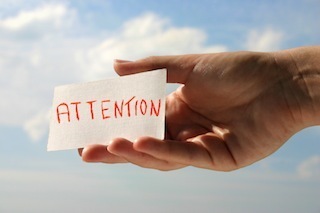 An old friend who is in town recently shared with me, “I look back on life and can’t believe the amount of time and energy I’ve put into events that never even happened.” His observation, which I think more of us identify with than we’d care to admit, was testament to the massive power of self-talk and the endless tributaries it sweeps us down. “What about this?” “How would that work?” “What if x, y or z happen?” The infamous tides of when, where, how, and if drag us through the currents of hypothetical conversations, speculative planning, strategizing retorts and other means of conjectured insanity – most of which lead to total dead ends, blatant non-occurrences. Over time, many of us realize, as my friend did, that we’ve spent enormous amounts of effort and anguish living for these non-starters. Likewise, it may be the external obsessions as much as the emotional rabbit holes that snatch us away – the lure of gadgets and overworking among many others. In a culture where the mundane is viewed as undesirable, we’re convinced we need all manner of distractions just to tolerate much of everyday life, and so we absorb and increasingly apply the practice of checking out. Whatever the source of our diversion, what are the real implications of this mental absence? On the flip side, what’s possible when we can operate more fully in the moment?
An old friend who is in town recently shared with me, “I look back on life and can’t believe the amount of time and energy I’ve put into events that never even happened.” His observation, which I think more of us identify with than we’d care to admit, was testament to the massive power of self-talk and the endless tributaries it sweeps us down. “What about this?” “How would that work?” “What if x, y or z happen?” The infamous tides of when, where, how, and if drag us through the currents of hypothetical conversations, speculative planning, strategizing retorts and other means of conjectured insanity – most of which lead to total dead ends, blatant non-occurrences. Over time, many of us realize, as my friend did, that we’ve spent enormous amounts of effort and anguish living for these non-starters. Likewise, it may be the external obsessions as much as the emotional rabbit holes that snatch us away – the lure of gadgets and overworking among many others. In a culture where the mundane is viewed as undesirable, we’re convinced we need all manner of distractions just to tolerate much of everyday life, and so we absorb and increasingly apply the practice of checking out. Whatever the source of our diversion, what are the real implications of this mental absence? On the flip side, what’s possible when we can operate more fully in the moment?
Distraction of various sorts can be a self-sabotaging undercurrent for all of our endeavors. In fact, it’s entirely possible to live an entire life that almost continuously hovers in some parallel plane, directed by the same old narratives, typical roles and emotional agenda regardless of what’s in front of our faces. We take up residence in this plane when we decide what’s in our heads is more real than what’s happening in the moment. The more distraction we identify with, the more we come to inhabit the deliberately imposed or internally playing static – and the less we take in of the actual events, people and settings around us. There’s the real tragedy, I think, (and the rather obvious evolutionary cautionary tale). We can lament the effort wasted on our inner shadow boxing or useless habits, but the sadder part is what we’ve missed as a result – all that’s been and gone while we were wrestling with the conditional and trivial.
To imagine an opposite scenario, I’ve heard it said that being present for all the tasks of our lives allows us to make a meditation of everything. Folding laundry can simply be folding laundry. (Wow – there’s a concept.) Apply the idea to the broader, (arguably) more significant dimensions of life and well-being, and we’re looking at some interesting possibilities. What can being more present in your workouts offer? What are the results of being fully in the moment while eating? What about being more present for your sleep routine (a seeming contradiction, I know)? What can “being there” mean for personal relationships?
Is Your Exercise About Engagement?
In extreme endeavors, such as serious surfing or competitive sports, presence is obviously crucial. It’s part of the discipline, in fact. When we have our “heads in the game” we’re really moving with the flow, that time bending force of pure, enjoyable focus. How many of us get this on a regular basis? How often are we one of the grim, sweaty faces slogging it out on a piece of gym equipment? I fully get that some days it’s enough to just get the job done, but how often do we honestly end up bringing this mindset to our physical activity? There’s a difference between “working out” to put in your time and participating with full mental engagement. (Which would you rather do and keep up over a lifetime?) If we have to put ourselves in zone out mode to fulfill our workout goals, are we shortchanging ourselves?
Endurance athletes who obviously do the same activity for extended periods collect their mental tricks – homing in on the aspects of their environments, gauging progress by the details of the route, etc. Yet, it’s not an out of body experience either. There’s even a new area of exercise science research that affirms the importance of mindfulness and acceptance (PDF), suggesting the practices can take us farther (literally and figuratively) than denial and distraction. Being fully conscious of the body’s sensations (however unpleasant) and emotionally assimilating the stress, burn or even pain can boost resilience and performance. Even if we’re not operating in the athletic arena but just trying to build personal Grok-worthy fitness, what can we do to get into the “heart” of our activity and fully back in our bodies. Trust me, replaying the day’s stress to get your mind off your exertion won’t get you far. The same goes for using anger as fuel. Instead of using a workout to “process,” we’re better off being with the immediate process (activity) itself. Reaching for music, I think, can be a unique exception and is often less a true distraction than an added layer or additional energy source playing parallel to the rhythm of physical motion.
Present Eating: Take a Seat.
Eating is unfortunately one of the most mindless things we do in our culture. Mindless snacking fodder inhabits whole rows of grocery stores. We’re often expected (or believe we’re expected) to scarf down lunch at our desks. We eat while we’re driving, while we’re watching T.V., while we’re holding meetings, while we’re doing laundry, loading the dishwasher. None of these scenarios hold much comparison to the simple or celebratory social practices that traditional peoples are known to apply to eating.
The discrepancy suggests an issue with time and attention as well as our relationship with food itself. Yes, it’s ultimately fuel to burn, and not every day can be a Norman Rockwell moment. That said, how we think about food impacts how our bodies processes it. How we enjoy it influences the satiety we experience. How healthy can our relationship to food be when the majority of eating happens while we have our nose in a phone or our mind on making the next exit? (No wonder we make the eating choices we do.) There’s something to stopping the car and sitting at the park to enjoy your lunch even if it’s just a hard-boiled egg and some cut vegetables. Go off automaton mode long enough to look at that tea you’re drinking. Ask yourself if the tiff with your spouse earlier in the day is at work in how much or what you reach for throughout the day. When you slow down and differentiate hunger from emotion, you can better appreciate the food you eat. Yet, it’s also about valuing yourself and the act of your own nourishment.
Being There – for Yourself and Others
Experts frequently bemoan the lack of communication and emotional skills in the younger, tech-dependent generation. Yet, how many of us would recognize our own behavior let alone feel good about it if we were flies on our own walls? How much do we let external distractions and personal moods influence our exchanges (or lack thereof) with those we love? Do our partners or children give up trying to get our attention as we respond to one more work email? Do we really hear what a friend is trying to tell us about her day as we decide a phone conversation is the perfect time to multitask as many household chores as we can? Do we stay in touch with what our physical bodies and emotional intuitions need from us at a given moment, or are we too hell-bent on powering through our days that we end up suffering the effects of chronic stress? Do we approach bedtime with a similar “zone out” mentality of consuming entertainment until our brains give out?
Being more present and fully accounted for to ourselves and others lends a different rhythm to life – one much more natural to the human operating system. My experience is that it unexpectedly slows down time. Less gets lost in the shuffle. There’s an intricate link between mindfulness and compassion for good reason. In fact, it can be rather shocking what we attune ourselves to and wonder how we got along without it – how our kids or other loved ones could’ve gotten along without it. We get to re-familiarize ourselves with the softness of our toddler’s hair, the contours of our partners face, the subtle hints our teenager drops about his/her interests and life questions these days as well as the shifts in ourselves – our own needs and evolving interests. (Ever feel the need to just catch up with yourself?) In being present, we stop simply responding. We turn off the auto-pilot. Instead, we open up space for interaction and observation that too often gets closed down in the thick of modern hubbub and mental chatter. It’s the space where intuition operates and intimacy flourishes – two of the most essential human instincts. Being present, in fact, puts us squarely in the immediate moment but accesses something of ourselves that’s evolutionarily fundamental. When we think about living with ancestral wisdom, being with the immediate moment taps us into one our most powerful Primal patterns.
Thanks for reading today, everyone. What does being present mean for your Primal journey? When/where have you noticed it working most in your life? Have a great end to the week.
Get the 7-Day Course on the Primal Blueprint Fundamentals for Lifelong Health Delivered to Your Inbox for FREE




August 6, 2014
Why the Omega-3/Omega-6 Ratio May Not Matter After All
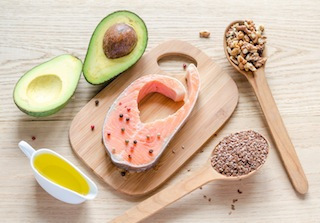 When it comes to omega-6 fats, the quick and dirty soundbite resonating throughout the ancestral health community has been “omega-6 fats are inflammatory, omega-3s are anti-inflammatory.” Years ago, I wrote a post saying essentially the same thing – that an excessive intake of omega-6s and inadequate intake of omega-3s predispose us to an exaggerated inflammatory response. This sounds right. And the huge discrepancy between the estimated ratio of omega-3 to omega-6 fats in ancestral human diets – 1:3, 1:2, or even 1:1 – and the ratio in modern diets – ranging from 1:25 to 1:10 – just looks pathological. Then, bringing up the rear, you’ve got Bill Lands’ work showing that human populations with low levels of omega-3s and higher levels of omega-6s in their tissues are at greater risk for many diseases like heart disease. It all seems clear cut, no?
When it comes to omega-6 fats, the quick and dirty soundbite resonating throughout the ancestral health community has been “omega-6 fats are inflammatory, omega-3s are anti-inflammatory.” Years ago, I wrote a post saying essentially the same thing – that an excessive intake of omega-6s and inadequate intake of omega-3s predispose us to an exaggerated inflammatory response. This sounds right. And the huge discrepancy between the estimated ratio of omega-3 to omega-6 fats in ancestral human diets – 1:3, 1:2, or even 1:1 – and the ratio in modern diets – ranging from 1:25 to 1:10 – just looks pathological. Then, bringing up the rear, you’ve got Bill Lands’ work showing that human populations with low levels of omega-3s and higher levels of omega-6s in their tissues are at greater risk for many diseases like heart disease. It all seems clear cut, no?
Well, kinda. While my general recommendation remains to limit omega-6 fats from vegetable oils, there’s more to the omega-6 story. First, let’s examine the main argument for the importance of the omega-3/omega-6 ratio.
The main argument for the importance of the balanced dietary ratio is that too much linoleic acid (the primary omega-6 fat) increases inflammatory precursors above and beyond the physiological norm, leading to an exacerbated inflammatory response, a general state of systemic inflammation, and the development of the various diseases with an inflammatory root.
Here’s how it’s supposed to work:
Linoleic acid converts to arachidonic acid (AA), a precursor for inflammatory cytokines.
Alpha linolenic acid (ALA; plant omega-3) converts to the anti-inflammatory precursors EPA and DHA, the omega-3 fatty acids we usually associate with fish oil.
Both of these conversions occur along the same rate-limited enzymatic pathway, which means they “compete” for a spot.
If we eat too much linoleic acid, the story goes, our tissue levels of AA will spike and predispose us to excessive inflammation and all the disease fallout that entails. Actually, increasing dietary linoleic acid doesn’t really increase the tissue level of arachidonic acid. Instead, since both linoleic acid and ALA use the same conversion pathway, an excess of linoleic acid does inhibit the conversion of ALA into EPA and DHA, leading to potential deficiencies in the latter nutrients and promoting an inflammatory environment – if you don’t eat preformed EPA and DHA in the form of seafood, pastured animal products, and/or supplements to make up for it.
That’s right: people for whom a fish dinner means battered and fried tilapia sticks are at risk of an inflammatory omega-3/omega-6 ratio, but people following a Primal way of eating are probably safe. Just eating some salmon, sardines, mussels, and pastured eggs can undo a lot of the damage caused when linoleic acid hogs the conversion pathway. Linoleic acid, however, is not directly increasing tissue omega-6 levels.
It appears as if the problem with low ratios of omega-3 to omega-6 is the lack of omega-3, not so much the omega-6. In studies that replace saturated fats with omega-6 fats, the only ones that show benefit are those that also include omega-3s with the omega-6s, while those that replace SFA with just omega-6 increase the risk of death. As long as you’re eating enough fish and other seafood, pastured animals and their fat (and eggs), and/or high quality fish oil supplements, whole food sources of omega-6 shouldn’t increase inflammation. The ratio is a helpful way to monitor your omega-3 and omega-6 intake, but it’s not a physiological law.
That’s not our only issue with linoleic acid, though. Where do we get our omega-6 fats?
No, not you reading this. Not the guy who asks that his eggs be cooked in butter or olive oil at the diner. Not the lady who shudders at the sight of one of those three gallon Costco jugs of corn oil. Where do most people living in industrialized nations get their omega-6s? You know, “normal” people.
Americans get almost 70% of their PUFA (mostly omega-6) from oils, shortening, and margarine and just 6% from beans, seeds, and nuts, 1% from eggs, and 13% from meat, poultry, and fish as of 2004 (PDF). So when we talk about omega-6 intake, we’re really talking about french fries (cooked in vegetable oil), packaged pastries (made with shortening), and processed, high-sugar, high-(vegetable)fat junk food intake.
If most of our omega-6 is coming from the linoleic acid found in cooking oils and processed baked goods, most of the omega-6 we’re eating is highly oxidized, rancid, and maybe even worse.
In one study, just 20 frying sessions were enough to drastically alter sunflower oil, oxidizing the fats and creating cyclic fatty acid monomers which – when eaten – affect fatty acid oxidation, carbohydrate metabolism, and liver enzymes. Dietary linoleic acid that has been oxidized via heat has been shown to directly lead to atherosclerosis. To determine how often most restaurants actually change their frying oil our for new oil, I looked at a topic called “How often do you clean your deep fryer?” in a popular online forum for diner owners. Responses varied from “every day” to “weekly,” with some topping off their oil as they went or relying mostly on filtration of solids. Either way, it’s not very reassuring.
The susceptibility to oxidation may be why diets high in linoleic acid have also been linked to increased oxidized LDL, while diets high in monounsaturated fat – like the traditional Greek diet, rich in extra virgin olive oil - produce considerably lower levels of oxidized LDL.
Omega-6 fat is thus “bad” because the most abundant source of it in our diet is heated vegetable oil, because it’s so susceptible to oxidation, because excessive heating can even create trans-fats out of it, because it’s a proxy for processed junk food, and because it contributes to oxidized lipids in our blood.
But what about whole foods that contain linoleic acid? Are they to be avoided?
Well, let’s look at a few and see what the research says.
Almonds
Both reviled for its linoleic acid and beloved for its easy metamorphosis into low-carb baking meal, the almond assumes a precarious position in the Primal community. But it’s much more than the bag of linoleic acid. An almond contains vitamin E, magnesium, prebiotic fiber, and protective polyphenols. Why does this matter, and how does it relate to the claimed health effects of excess linoleic acid?
Magnesium deficiency is strongly related to lipid peroxidation in vivo – the very same thing we’re trying to avoid by limiting omega-6 fats.
Vitamin E protects the linoleic acid from oxidation (that’s why vitamin E tends to come packaged with linoleic acid in nature, because plants don’t like their fats oxidizing, either).
The polyphenols found in almond skins protect LDL from oxidation, too, especially when combined with the vitamin E found in almond meat.
Almond prebiotics are also beneficial, leading to a healthier, more diverse intestinal microbiota.
Brazil Nuts
Or the Brazil nut, famous repository of “so much omega-6!” Yeah, okay, but it’s also a good source of magnesium, vitamin E, and selenium. We’ve already covered how magnesium and vitamin E can counter any potential negative effects of the linoleic acid they come packaged with, so let’s discuss the selenium in Brazil nuts.
One common complaint about linoleic acid is that it depresses the metabolism by interfering with thyroid function; the Ray Peat fans are fairly adamant about this one in particular. However, selenium is one of the most important pro-thyroid minerals in existence. It allows the conversion of the storage thyroid hormone (T4) into the active thyroid hormone (T3). T3 is what increases metabolism, improves LDL clearance by increasing LDL receptor activity, and generally does most of the positive stuff we associate with the thyroid. And arguably the best, and certainly the easiest, way to get enough selenium is by eating a couple Brazil nuts (a slab of sockeye salmon ain’t too shabby a selenium source, either).
It’s no surprise, then, that a single bout of acute Brazil nut ingestion results in long term depression of inflammatory markers.
Walnuts
Conventional wisdom says walnuts are healthy. Primals worry about linoleic acid intake, and walnuts are loaded with it (along with some ALA). How do they fare in the literature?
Walnut meals (as in a plate of food that’s 75% walnut) reduce the propensity of blood lipids to oxidize (almond meals had similar effects).
Walnuts increase Apo-A1 (a good lipid marker) and adiponectin (an anti-inflammatory hormone).
Walnuts lower Apo-B, a rough surrogate for LDL particle number.
Seems they fare pretty well.
Pistachios
Then you’ve got pistachios which, despite their linoleic acid content (13.5g/100g), manage to lower the level of oxidized LDL particles in pistachio-eaters by improving lipids and increasing antioxidant status. They’re also excellent sources of prebiotics, improving the gut microbiota by a greater degree than even almonds.
Hazelnuts
Hazelnuts, which aren’t that high in linoleic acid compared to some other nuts, are quite good at reducing LDL oxidation and inflammatory markers in patients with elevated cholesterol.
Avocados
The avocado is rather rich in linoleic acid (though most of the fat is monounsaturated), leading some among us to avoid or severely limit its consumption. But research in actual avocado-eating humans paints a different story. An avocado eaten with your meal lowers the postprandial inflammatory response, triglyceride increase, and endothelial dysfunction normally associated with meals. Avocados also lower the number of LDL particles in your blood, a significant (and probably real/causative) risk factor for heart disease. I mean, c’mon. No guacamole? No diced avocado in your salad? That’s not living.
It’s tough to reconcile this notion of linoleic acid being wholly bad with the overwhelming evidence for the health benefits of nuts and avocados, and I’ve never really bought into it. Omega-6 intake is strongly associated with age-related macular degeneration, for example, but nut intake is not. And I’m not just talking about epidemiological studies, since those are confounded by the fact that nuts and avocados are generally considered to be healthy foods, and people who eat a lot of them are more likely to do other healthy things, like exercise regularly, drink moderately rather than to excess, eat lots of vegetables, and maintain a healthy weight. The above studies are largely well-controlled, with live human subjects – just like you.
I’m not saying you should eat a cup of almonds every day, or forsake all vegetables save the avocado. I’m simply saying you needn’t fear these foods, for they are undoubtedly healthy foods in reasonable amounts (like most others). Foods. See that word? Fear the isolated, super-heated, burnt fatty acids, if you like. I don’t blame you. But nuts? These are complex nutrient matrices teeming with as-yet undiscovered bioactive compounds. Yeah, maybe one day some enterprising biohacker will identify, isolate, and quantify the effects of every last micronutrient in every food and then create the final perfect iteration of Soylent. Until then, the best option we have is to eat food – whole foods that make us feel and look good, help us perform well, and have solid scientific backing. I’d say that’s a pretty good option.
Linoleic acid in the form of refined vegetable oils is still to be avoided. But I’m just not convinced whole food sources of linoleic acid have the same effect on us. We call out other researchers when they demonize a food we like because of a single component, for good reason. We should be careful not to practice nutritional reductionism to justify demonizing a nutrient we don’t like.
Don’t you think?
Thanks for reading, everyone. Let me know what you think about all this. Did you fear avocados before reading this? Do you still?
Join Mark Sisson and Friends in Sunny Southern California this Sept. 25-28! Get Your Tickets for PrimalCon Oxnard 2014 Today and Finally Meet Your Tribe!




August 5, 2014
Is Processed Meat Actually Bad for You?
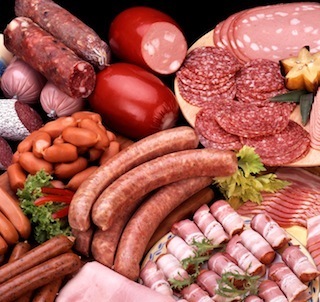 While popular media coverage of people following a Primal way of eating tends to paint us as carnivorous meat enthusiasts gorging on steaks, bacon, bun-less hotdogs, and little else without regard for quality, in truth we are far more discerning about our choices of meat. We prefer pastured pork and poultry, grass-fed and finished beef, lamb, and bison, and generally deplore the conditions of concentrated animal feeding operations (CAFOs). And many of us actively limit processed meat – sausages, bologna, lunch meats, bacon, and the like. You’ll often catch us coming down quite hard on processed meat altogether, making a point to distinguish between its health effects and those of unprocessed meat when responding to studies that lump the two together as “meat.”
While popular media coverage of people following a Primal way of eating tends to paint us as carnivorous meat enthusiasts gorging on steaks, bacon, bun-less hotdogs, and little else without regard for quality, in truth we are far more discerning about our choices of meat. We prefer pastured pork and poultry, grass-fed and finished beef, lamb, and bison, and generally deplore the conditions of concentrated animal feeding operations (CAFOs). And many of us actively limit processed meat – sausages, bologna, lunch meats, bacon, and the like. You’ll often catch us coming down quite hard on processed meat altogether, making a point to distinguish between its health effects and those of unprocessed meat when responding to studies that lump the two together as “meat.”
And as much as we reiterate that observational studies cannot establish causation, processed meat consumption is consistently linked to poor health outcomes. Now, it could very well be that processed meat consumers tend to do other unhealthy things, like not exercise, sleep poorly, eat other processed foods, eat buns with their hot dogs and pizza dough with their pepperoni. Researchers usually try to control for at least some of those variables, but it’s impossible to cover every unhealthy aspect of a person who simply doesn’t care about their health. You can’t quantify everything. That likely explains much of the relationship between processed meat and poor health outcomes.
But let’s assume for a second that the observational studies do show causative relationships. What could be causing it?
Nitrosamines
Nitrosamines are carcinogenic compounds. In animal studies, they’re used to reliably give rodent subjects cancer. In observational studies, they’re linked to human cancers. Nitrosamines form when nitrites (a common preservative in processed meats) bond with amino acids (also found in meats); this can occur during the processing of the meat or in the stomachs of those who eat it. Since processed meats contain both nitrites and amino acids, it’s kind of a perfect storm. Case closed?
Not quite. Another excellent source of nitrates (which convert to nitrites in the body) are most of the vegetables we eat, particularly the green ones. In fact, the majority of the nitrates we consume come from vegetables – not bacon or hot dogs or head cheese (well, maybe except for that German kid I went to grade school with who ate nothing but thick slices of head cheese in between rye bread every day for lunch). Plus, the majority of the nitrosamines we’re exposed to come from endogenous formation in our stomachs, not from dietary pre-formed nitrosamines. And endogenous nitrosamine formation can occur without any processed meat at all. A meal of fish (amino acids) and greens (nitrates which commensal oral bacteria convert to nitrite), for example, could conceivably increase nitrosamine formation, but I don’t think that means fish and greens are unhealthy.
For a good look at the overall nitrite/nitrate issue, check out Chris Kresser’s great post from a couple years ago.
Poor Quality Animals
Your average salty slab of beige pseudo-meat doesn’t come from a pastured animal. Obviously. Those Oscar Mayer wieners quivering in the dusky summer light of a million American backyard barbecues? Every bite contains bits and pieces from hundreds of individual animals who never knew what it was like to walk on grass. Even in countries like Italy, whose traditionally-cured meats are famous the world over, industrial farming is replacing smaller, more intimate farming. It doesn’t matter how many traditional Mediterranean arm hairs you find in your guanciale. Unless the package mentions it, or the producer confirms it, the majority of processed meat is made from CAFO cows, pigs, and poultry who ate corn (and its oil) and soy (and its oil) centric diets and have imbalanced fatty acid ratios (more omega-6 PUFA, less saturated/monounsaturated/omega-3 PUFA). That isn’t to say that it’s terrible for you, or that you can’t mitigate the imbalance by consuming more omega-3s, but it is to say that when you eat processed meats, you’re more often than not not eating the best quality meat you can get your hands on.
Oxidized Lipids (Cholesterol and Fatty Acids)
We all know about the formation of oxidized cholesterol and oxidized fatty acids in foods cooked at high temperatures, and we all know why we should limit these whenever possible: they can be incorporated into our serum cholesterol, increasing its oxidative instability and our oxidative stress, and eventually leading to atherosclerosis. During processing, many processed meats are cooked at temperatures high enough to oxidize the lipids before they even reach your local grocery store. Things like precooked breakfast sausages, hot dogs, and Vienna sausages qualify (PDF). Processed meats like mortadella (which is baked at a low heat) and salami (which is cured but not cooked), however, are relatively free of oxidized lipids. As a general rule, the higher the polyunsaturated fat content of the meat (CAFO-fed pork and poultry are especially high in PUFA), the greater the potential for oxidized fats. Sure, overcooking fresh, unprocessed meat can oxidize the lipids, too, but you’re starting from scratch. The problem with precooked processed meats is that you’re starting from behind.
A Skewed Potassium/Sodium Ratio
In the opinion of many researchers, the potassium/sodium ratio is far more important than the absolute amount of sodium a person eats. We can see how processed meat might impact this ratio:
With a diet based on unprocessed meat, the ratio is far easier to monitor and optimize. You control the flow of salt, adding as much or as little as you want. Fresh meat itself also has a favorable potassium/sodium ratio, and the rarer you eat your meat, the more potassium-rich juices you’ll consume.
With a diet based on processed meat, a favorable ratio is difficult to maintain. For one, many processed meats arrive pre-cooked and/or with all (potassium-rich) moisture removed, which removes or destroys much of the potassium. And two, most processed meats come heavily salted, further throwing off the ratio.
Heterocyclic Amines
When meat is directly exposed to high temperature, the amino acids, sugars, and creatine within it react to form heterocyclic amines (HCA), which are mutagenic in animal studies and linked to cancer of the prostate, pancreas, and colon in observational studies. Certain processed meats can have signficant amounts of HCAs, with well-done (almost burnt) bacon and sausage showing more than hot dogs, deli meat, and pepperoni, but fresh meats exposed to high heat cooking (like rotisserie chicken skin) usually have more.
And so it’s a mix of real problems and overblown threats. As you can probably see, not all of these problems are inherent to processed meat and many of them can be countered with proper precautions:
Eat fruits and vegetables, especially alongside your meats (processed or otherwise). Drink tea and coffee, eat dark chocolate, consume berries, enjoy phytonutrient-rich spices like turmeric freely and wantonly. Plant foods often contain protective compounds that inhibit carcinogen formation (like nitrosamines) in the stomach. They’re also good sources of potassium.
Treat cured meats as condiments that enhance your vegetable and fresh meat dishes, not main courses. This will allow you to use and afford high-quality cuts with better nutrient and fatty acid profiles, since you aren’t blowing through them so quickly and they’ll last longer. This will also dampen the potential health impact of poorer quality cuts if you go that route, since you’re not eating so much in one sitting.
Don’t overcook your processed meats. Don’t burn your bacon. Follow the gentle cooking techniques I recommend whenever possible (if you even need to cook them at all).
So, how much processed meat should you be eating? Eh, hard to say. A little bacon with your eggs here (okay, a lot), maybe some charcuterie there as an appetizer before a dinner party, some diced pancetta with Brussels sprouts – this is pretty typical among the crowd that reads this blog. I strongly advise against basing your diet on pepperoni, bacon, and hot dogs – even high-quality ones using grass-fed and pastured animals – but I think that goes without saying. In the end, the majority of Primal eaters are not basing their meals on processed meat.
That said, there’s really something therapeutic about an occasional plate of perfectly crispy, thick-cut bacon, isn’t there?
Thanks for reading, all. Let me know what you think about all this in the comment section.
Join Mark Sisson and Friends in Sunny Southern California this Sept. 25-28! Get Your Tickets for PrimalCon Oxnard 2014 Today and Finally Meet Your Tribe!




Mark Sisson's Blog
- Mark Sisson's profile
- 199 followers



